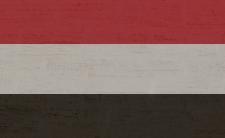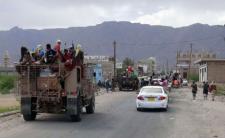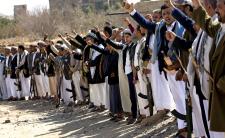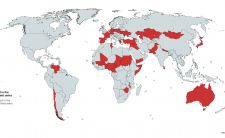The Republic of Yemen is home to one of the oldest civilizations in the Near East. The country is bordered by Saudi Arabia in the north, Oman in the east, Somalia in the south, and Eretria and Djibouti in the west. It is also bordered on three sides by water. The Red Sea separates Yemen from Africa in the west, while the Gulf of Aden and the Arabian Sea are to the south. It covers nearly 530,000 square kilometres of land and is home to over 24 million people, most of whom are Arab Sunni or Shi’a Muslims. However, there are minority populations of Afro-Arabs, Europeans, and South Asians who account for the Hindu, Christian, and Jewish presence in Yemen.
Constitutional History
In 897 A.D., a Zaidi ruler named Yahya al-Hadi ila'l Haqq founded a dynasty in Yemen that would last into the modern period. However, after a period of regional disputes over who would control the area, the Ottoman Empire invaded in 1517. The Ottomans would rule the territory until 1918 when their forces were expelled by the Zaidi. While the Zaidi were able to establish the independent Mutawakkilite Kingdom of Yemen in the north, the British maintained a protectorate around the port of Aden in the south. A military coup in 1962 led to the foundation of the Yemen Arab Republic, but royalist forces backed by Saudi Arabia and Jordan began the North Yemen Civil War, which ended in 1967 with the reestablishment of the Zaidi Imams.
This war spilled over into the southern British territory, which led Britain to announce in 1966 that it would remove all its troops from the south and grant the area independence. During the drawdown of 1967, the National Liberation Front, which had previously fought against British rule, managed to take control of the port of Aden and assumed power, creating the independent People’s Republic of South Yemen. By 1968, power consolidated in the new government, but a new radical Marxist wing of the NLF managed to gain power in the following year. The name of southern Yemen was changed to the People’s Democratic Republic of South Yemen.
Relations between the north and the south were relatively friendly throughout the 1970s, leading to an agreement to merge in 1972. However, the actual merger was put on hold in 1979 and again in 1986 over tensions surrounding the influx of southern refugees to the north due to poverty and a decline in Soviet economic support. Despite this, the leaders of the north and the south agreed to renew discussions of unification, to establish a joint oil venture, to demilitarize the border, and to allow unrestricted access for all Yemenis across the border. The following year, the two sides also agreed on a unity constitution drafted in 1981. On 22 May 1990, the two countries were officially united into the Republic of Yemen, while a constitution was ratified by the populace in May 1991. However, a civil war broke out in Yemen in 1994 between the north and the south. The south seceded on 21 May 1994 to form the Democratic Republic of Yemen, but northern forces captured Aden on 7 July of the same year. While the country was reunited, the constitution underwent some significant amendments. The Constitution was again amended in 2000 and 2001 to strengthen the power of the executive branch and to create a bicameral legislature.
1991 Constitution and Amendments
The Yemeni Constitution of 1991 was drafted to affirm the country’s commitment to free elections under a multi-party system while affirming the right to hold private property. It includes individual rights, recognizes respect for human rights, and states that all are equal under the law. The Constitution also recognizes Yemen’s Islamic heritage, stating that Yemen is part of a larger Arab nation and Islamic world, where Islam is the state religion, and that Islamic jurisprudence is the main source of legislation. While power is divided between a President, Prime Minister, Council of Ministers, a bicameral legislature, and a Supreme Court, the Constitution is clear that power resides ultimately in the people through their ability to elect representatives and the referendum.
Executive branch
Under the 1991 Constitution, the executive power is exercised by a Presidential Council of 5 members elected by the legislature to 5 year terms. Headed by a Chair elected from among its ranks, it is the duty of the Council to represent the State internally and externally, to call for referenda, to appoint the Prime Minister, to ratify and execute laws, to grant pardons and honours, to ratify treaties, to appoint ambassadors, and to declare a state of emergency. In addition to the Presidential Council, the Constitution also creates a Council of Ministers. Members of this Council are selected by the Prime Minister in consultation with the Presidential Council to be approved by the legislature. It is the Ministers’ duty to draft, in conjunction with the Presidential Council, and execute state policy, prepare and implement budgets, draft bills for submission to the Presidential Council or the legislature, coordinate and oversee other government agencies, and appoint officials. The Prime Minister is in charge of supervising this effort and insuring that the Government functions smoothly and in a unified manner. Ministers and the Prime Minister may be removed by the Presidential Council on recommendation of the legislature or the Prime Minister due to crimes committed during or in pursuit of their responsibilities, as confirmed by a court.
The 1994 Amendments to the Constitution significantly changed the executive branch by replacing the Presidential Council with a single, popularly elected President. Under this amendment, the President is nominated by the legislature and approved by a direct vote, though the Constitution is clear that the legislature must nominate at least two people. The President is the Supreme Commander of the Armed Forces and the Head of State. However, his stated tasks are the same as the former Presidential Council. While the 1994 Amendments stated that the President could only assume two five year terms, the 2000 Amendments extended his term by two years. The Council of Ministers remained the same.
Legislative branch
Under the 1991 Constitution, the legislature was unicameral, consisting of the House of Representatives. Each member of the House is elected by direct vote to 4 year terms though the amendments of 2000 extended this term to 6 years. The House is tasked with enacting laws and creating national policy, drafting the budget and development plans, and approving treaties. It also has the power of interpellation, and may recommend the removal of the Prime Minister or Ministers to the Presidential Council. The Prime Minister must seek the House’s approval on the formation of his Government before any Minister may be appointed. The House may also withdraw its confidence from the Government, the Prime Minister, or a Minister by a majority vote. Any member of the House may only be removed if he loses the constitutional requirements for membership, gets caught in the act of committing a crime, or resigns. The House may be dissolved by the Presidential Council.
On 20 February 2001, a constitutional amendment made the legislature bicameral by adding the Shura Council. The Shura, or Consultative, Council is comprised of 111 members appointed by the President. Its powers are mainly advisory, as it has the ability to commission reports, forward proposals, and provide counsel to other government bodies. The Shura Council holds joint sessions with the House in order to second nominations for President, approve development and budget plans, ratify treaties, and anything else the President decides requires a vote of both houses.
Judicial branch
The judicial power of Yemen under the 1991 Constitution is invested in a lower court system as determined by law and a Supreme Court, all regulated by an executive-appointed Supreme Judicial Council. While the Constitution states that the judiciary is independent, the Supreme Judicial Council has the ability to control appointments, promotions, and removals, placing judges under de facto executive control. The lower courts are headed by the Supreme Court, also regulated by the Supreme Judicial Council. The Supreme Court has the power of constitutional review, to decide conflicts between judicial bodies, to hear electoral challenges, and to act as a court of civil and criminal appeals concerning personal, disciplinary, and administrative questions. It may also hear cases against the President, Vice-President, the Prime Minister, and other Ministers.
Political Challenges
Since the passage of the constitution and the unification, Yemen has continued to experience some internal unrest. Tensions between the north and the south continue, as many southerners continue to believe that the north has been receiving more economic benefits. The southern secessionist movement reappeared when a 2008 protest movement cited an independent southern state as one of its goals. While the government was still combating these groups, Huthi rebels rose up in 2004 in the north, seeking a return to traditional Zaydi Islam. A ceasefire was finally signed with the Huthi in 2010 after several rounds of intense fighting which resulting in hundreds of deaths and thousands of displaced persons. However, Yemen was then forced to confront its reputation as a terrorist haven. A Yemen branch of Al Qaeda claimed responsibility for a failed attack on a U.S. airliner in 2009, and even though the government then claimed to be committed to cracking down on terrorists, efforts against Al Qaeda militant groups in Afghanistan and Iraq led to renewed fears that Yemen was still a hot bed of terrorist activity.
Regional, political, and economic tensions resulted in nationwide protests in the spring of 2011. Fuelled by complaints of high unemployment, corruption, and poor economic conditions, protests eventually extended to rejection of a government proposal to amend the 1991 Constitution and the resignation of President Ali Abdullah Saleh. Efforts by the government proved unable to quell the popular protests, even when the President declared that he would not seek re-election or hand power over to his son. Protests across the country numbered in the tens of thousands, and violent clashes between the protestors and government forces resulted in some deaths. Saleh was rushed to a hospital in Saudi Arabia to be treated for injuries sustained after a rocket attack on his compound in June 2011. Saudi Arabia’s King Abdullah was able to broker a ceasefire shortly after between protestors, tribal leaders, and Vice-President Abd al-Rab Mansur al-Hadi. President Saleh has been in power for over 30 years, and his party is the dominant party in the government. There has been speculation as to whether the injured President will return to retake power as he claims, or if a new Constitution will be drafted in the wake of popular demands for a more democratic and representative system with a weaker executive and stronger legislative branch.
Yemen’s judicial system is hampered by widespread corruption and judges are often undermined or harassed by tribal leaders who, in possession of their own set of courts, manage to exercise much influence over the law be hearing civil, criminal, and religious cases, even though its jurisdiction only extends to non-criminal cases. The government has been reluctant to enforce judicial decisions due to these weaknesses, but in December 2005, it announced a 10-year plan to reform the courts, make them more independent, and provide them with better judges.
System of Government under Amended 1991 Constitution
Timeline
| 897 | Zaidi dynasty founded |
| 1517 | Ottoman Empire invades |
| 1630 | Imam Qasim the Great expels the Turks |
| 1830 | Ottoman Empire retakes Yemen due to internal division within the Zaidi |
| 1839 | British take control of the port of Aden in the south of Yemen |
| 1869 | Suez Canal opening |
| 1904 | British and Ottoman agree to a border between the north and the south, Zaidi begin guerrilla war |
| 1918 | Ottoman forces leave Yemen and Imam Yahya Muhammad established the Mutawakkilite Kingdom of Yemen in the north |
| 1930 | Oil discovered in the port of Aden |
| 1948 | Ahmad bin Yahya succeeds to the throne in the north |
| 1962 | Military coup creates the northern Yemen Arab Republic, civil war begins between the royal government forces backed by Saudi Arabia and Jordan and coup forces backed by Egypt |
| 1964 | National Liberation Front established in the south and begins guerrilla campaign against the British |
| 1966 | British announce that they will withdraw their troops upon southern Yemen’s independence, socialist Front for the Liberation of Occupied South Yemen founded and begins campaign against the NLF and the British |
| 1967 | North Yemen Civil War ends in withdrawal of Egyptian forces, Suez Canal closes and British withdraw from south Yemen, NLF takes power in the new People’s Republic of South Yemen |
| 1969 | Marxist wing of the socialist party takes control of the south, renaming it the People’s Democratic Republic of South Yemen |
| 1972 | North and south agree to merge |
| 1978 | Ali Abdallah Saleh becomes President |
| 1979 | Massive exodus of southern Yemeni into the north breaks down unity process and almost leads to a war, PDRSY begins funding leftist groups in the north |
| 1986 | Party split in the south leads to more refugees, but plans to unify re-affirmed |
| 1987 | North and south agree to a unity constitution drafted in 1981 |
| 22 May 1990 | North and south officially unify into the Republic of Yemen |
| May 1991 | Popular referendum accepts a new constitution |
| 1994 | Separatists in the south begin a civil war, Southern rebels secede to form the Democratic Republic of Yemen, but northern forces capture Aden and win the war, Constitutional amendments expand the power of the President |
| 2000 | Constitutional amendments lengthen the terms of office for the President and members of the House of Representatives |
| 2001 | Constitutional amendments create a bicameral legislature |
| 2004 | Huthi rebels in the north rise up for return to Zaydi Islam |
| 2006 | President Saleh wins a second term as President |
| 2008 | Southern secessionist movement reappears in the south in the form of popular protests |
| 2009 | Yemen branch of Al Qaeda claims responsibility for failed attack on U.S. airliner |
| 2011 | Popular protests calling for political and economic reforms, President Saleh badly injured during an attack on his compound |
Bibliography
- United States. CIA World Factbook: Yemen. , 2011. Web. 8 Jul 2011.
- Yemen Country Profile." 07/06/2011. BBC News. Web. 8 Jul 2011.
- United States Department of State. Background Note: Yemen. , 2011. Web. 8 Jul 2011.
- "Constitution of Yemen." UNHCR Refworld. Web. 8 Jul 2011.
- Carapico, Sheila. Civil Society in Yemen: The Political Economy of Activism in Modern Arabia. New York, NY: Cambridge University Press, 1998. Print.
| Branch | Hierarchy | Appointment | Powers | Removal |
|---|




Share this article